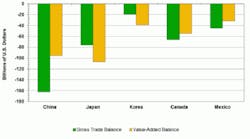A number of studies have come out recently, including several published by MAPI, pointing out shortcomings in the way the government measures such key factors as output, productivity and trade flows. This is important because how we measure manufacturing has broader implications for society. For starters, federal metrics provide a trend line on the health of the economy's most influential sectoran influence that more and more policymakers are starting to acknowledge. As Gene Sperling, head of the president's National Economic Council, recently reflected, when you take into account the role that manufacturing plays in innovation, higher-wage jobs, exports and other factors, "it becomes clear that manufacturing is worthy of a special emphasis."
How government measures manufacturing is also important because it has policy implications. Misperceptions can lead to bad policy decisions: Just as deceptively rosy scenarios can tamp otherwise critical issues down below policymakers' radar, bleak scenarios that are flawed can lead to calls for misplaced action.
Unfortunately, because federal statistical agencies do not have the resources to accurately track manufacturing data, we may have both situations today.
Take the way the Bureau of Labor Statistics and the Bureau of Economic Analysis measure productivity. A recent Brookings Institution report argues that the way these agencies track data probably leads to overstating manufacturing productivity growth. In "Why Does Manufacturing Matter? Which Manufacturing Matters?", Case Western Reserve University economist Susan Helper points to several measurement flaws. First, the government has not taken into account the long-term increase in the share of imported inputs -- created through low-cost country sourcing and the offshoring of some component production. Government statisticians do not fully capture the price reduction of intermediate inputs which overstates manufacturing productivity. Second, the government does not take into consideration the heightened use by manufacturers of temporary help services in their operations. Not officially counting these workers, who indeed are helping make goods because they are counted as service-industry workers, gives the deceptive appearance that fewer employees are needed on the shop floor to make products.
As a result, according to Helper and others, manufacturing productivity growth is overstated, particularly since 2000.
Then there's the way the government tracks trade flows. MAPI Economist Yingying Xu recently offered insights into the challenge the federal government has in tracking inputs and outputs in a global marketplace. In her report "Understanding International Trade in an Era of Globalization," she observes that with modern supply chains, intermediate inputs must cross national borders multiple times before being transformed into a final product. Current customs-based trade statistics double count intermediate trade flowsonce flowing into a country as an imported intermediate material and again flowing out incorporated into an export product. The national trade statistics have become less reliable as a measure of understanding in which country value was added, which is the source of economic growth. Disentangling the flows of world trade to identify when value is added does not change the United States' top-line trade deficit, but it would demonstrate how benefits of trade accrue more broadly to U.S. companies than the data would suggest.
As MAPI's Chief Economist Dan Meckstroth concluded in a recent analysis, "The sluggish manufacturing performance during the 2000s is a national problem, and the health of the manufacturing sector should be a source of concern for the long-term welfare of the nation."
Stephen Gold is president and CEO of Manufacturers Alliance for Productivity and Innovation (MAPI), an executive education and business research organization in Arlington, Va. (www.mapi.net).




